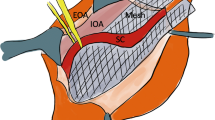Abstract
Background
It is generally stated that preoperative differentiation between indirect and direct inguinal hernias by physical examination is inaccurate and irrelevant. With the expansion of the laparoscopic technique, new relevance has emerged. Laparoscopic correction of an indirect hernia is more challenging and time consuming than laparoscopic correction of a direct hernia. Preoperative knowledge concerning the type of hernia informs the laparoscopic surgeon about the required expertise and the expected operative time, and this knowledge is useful for training programs and management. The authors therefore developed a new accurate and easy method of physical examination to differentiate types of inguinal hernia. A prospective study was conducted to determine the accuracy of this new method that combines physical examination with a hand-held Doppler device (not ultrasound) to differentiate types of inguinal hernia.
Methods
This prospective diagnostics study consisted of two consecutive parts. Each part included 100 consecutive patients presenting with an inguinal hernia. The inguinal occlusion test was used to differentiate the types of inguinal hernia during physical examination in the first part of the study. A hand-held Doppler device was used for adequate localization of the epigastric vessels in addition to the occlusion test in the second part of the study. Preoperative remarks were compared with findings during laparoscopic inguinal hernia repair. The McNemar symmetry χ 2 test was used for statistical evaluation
Results
The first part of the study showed a preoperative accuracy of 35 % for direct inguinal hernias and 86 % for indirect inguinal hernias (p < 0.001). The second part of the study showed a preoperative accuracy of 79 % for direct inguinal hernias and 93 % for indirect inguinal hernias (p < 0.001)
Conclusion
The inguinal occlusion test combined with the use of a handheld Doppler device is accurate in distinguishing direct and indirect inguinal hernias and provides useful management information in laparoscopic inguinal hernia repair.

Similar content being viewed by others
References
Ijpma FA, Van de Graaf RC, Van Geldere D, Van Gulik TM (2009) An early observation on the Anatomy of the Inguinal Canal and the Etiology of Inguinal Hernias by Petrus Camper in the 18th century. World J Surg 33:1218–1324
Kraft BM, Kolb H, Kuckuk B, Haaga S, Leibl BJ, Kraft K, Bittner R (2003) Diagnosis and classification of inguinal hernias. Surg Endosc 17:2021–2024
Van den Berg JC, de Valois JC, Go PM, Rosenbusch G (1999) Detection of groin hernia with physical examination, ultrasound, and MRI compared with laparoscopic findings. Invest Radiol 34:739–743
Burkhardt JH, Arshanskiy Y, Munson JL, Scholz FJ (2011) Diagnosis of inguinal region hernias with axial CT: the lateral crescent sign and other key findings. Radiographics 31:E1–E12
Sanjay P, Fulke JL, Shaikh IA, Woodward A (2010) Anatomical differentiation of direct and indirect inguinal hernias: is it worthwhile in the modern era? Clin Anat 23(7):848–850
Ralphs DN, Brain AJ, Grundy DJ, Hobsley M (1980) How accurately can direct and indirect inguinal hernias be distinguished? Br Med J 280:1039–1040
Moreno-Egea A, Girela E, Canteras M, Martinez D, Aguayo JL (2000) Accuracy of clinical diagnosis of inguinal and femoral hernia and its usefulness for indicating laparoscopic surgery. Hernia 4:23–27
Cameron AE (1994) Accuracy of clinical diagnosis of direct and indirect inguinal hernia. Br J Surg 81:250
Kark A, Kurzer M, Waters KJ (1994) Accuracy of clinical diagnosis of direct and indirect inguinal hernia. Br J Surg 81:1081–1082
Simons MP, Aufenacker T, Bay-Nielsen M, Bouillot JL, Campanelli G, Conze J, de Lange D, Fortelny R, Heikkinen T, Kingsnorth A, Kukleta J, Morales-Conde S, Nordin P, Schumpelick V, Smedberg S, Smietanski M, Weber G, Miserez M (2009) European hernia society guidelines on the treatment of inguinal hernia in adult patients. Hernia 13:343–403
Sanjay P, Reid TD, Bowrey DJ, Woodward A (2006) Defining the position of deep inguinal ring in patients with indirect inguinal hernias. Surg Radiol Anat 28:121–124
Conaghan P, Hassanally D, Griffin M, Ingham Clark C (2004) Where exactly is the deep inguinal ring in patients with inguinal hernias? Surg Radiol Anat 26:198–201
Koliyadan SV, Narayan G, Balasekran P (2004) Surface marking of the deep inguinal ring. Clin Anat 17:554–557
Andrews BT, Burnand KG, Ferrar D (1999) Putting a finger on the deep inguinal ring. J R Coll Surg Edinb 41:90–92
Scott PD, Willan PLT (1991) Anatomical mythology? A study of surface markings of the inguinal region. Clin Anat 4:216–222
Bradley M, Morgan D, Pentlow B, Roe A (2003) The groin hernia: an ultrasound diagnosis? Ann R Coll Surg Engl 85:178–180
Zhang GQ, Sugiyama M, Hagi H, Urata T, Shimamori N, Atomi Y (2001) Groin hernias in adults: value of color Doppler sonography in their classification. J Clin Ultrasound 29:429–434
Korenkov M, Paul A, Troidl H (1999) Color duplex sonography: diagnostic tool in the differentiation of inguinal hernias. J Ultrasound Med 18:565–568
Babkova IV, Bozhko VV (1999) Ultrasound assessment in diagnosis of uncomplicated inguinal hernia. Khirurgiia 2:46–50
Disclosures
Wouter G. Tromp, Baukje van den Heuvel, and Boudewijn J. Dwars have no conflicts of interest or financial ties to disclose.
Author information
Authors and Affiliations
Corresponding author
Rights and permissions
About this article
Cite this article
Tromp, W.G., van den Heuvel, B. & Dwars, B.J. A new accurate method of physical examination for differentiation of inguinal hernia types . Surg Endosc 28, 1460–1464 (2014). https://doi.org/10.1007/s00464-013-3359-8
Received:
Accepted:
Published:
Issue Date:
DOI: https://doi.org/10.1007/s00464-013-3359-8




